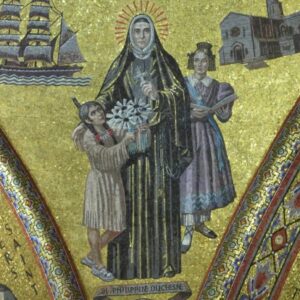 St. Rose Philippine Duchesne was born in 1769 in Grenoble, France. Her father, Pierre Francois Duchesne, was a lawyer, businessman, and prominent civic leader, while her mother, Rose Perier, was a member of a leading family from the Dauphine region. From the young age of eight, St. Rose had a desire to be a missionary in the Americas, sparked by hearing a Jesuit missionary priest speak of his work there.
St. Rose Philippine Duchesne was born in 1769 in Grenoble, France. Her father, Pierre Francois Duchesne, was a lawyer, businessman, and prominent civic leader, while her mother, Rose Perier, was a member of a leading family from the Dauphine region. From the young age of eight, St. Rose had a desire to be a missionary in the Americas, sparked by hearing a Jesuit missionary priest speak of his work there.
In 1804 she joined the Society of the Sacred Heart, which sent her to the United States in 1818. From the convent and school she founded at St. Charles, Missouri, she traveled over a wide area, founding schools for girls, doing charitable work, and (as had been her dream) finally ministering to Native Americans. She was a valiant missionary and well-known for her generous care for children. She spent her last ten years in “retirement” in a tiny shack at the convent in Saint Charles, where she lived austerely and in constant prayer. In fact, she was found praying on her knees in an open, dirt field so often that the Native American children called her “The Woman Who Prays Always.”
Perhaps that open, dirt field can remind us that there is no exclusively “holy place,” although certain places are of special significance to us. But, as St. Paul reminds us, each baptized person is “a temple of the Spirit” and is to act as such and be respected as such. “Wherever two or three are gathered together in my name, there I am in the midst of them,” Jesus told His disciples (Matthew 18, 20). So, although we may see a gathering at a Solemn Papal Mass in the magnificent Basilica of St Peter’s in Rome as unique and special, such an event would not have a monopoly on the title “holy place.” An elderly homebound person who quietly prays from their living room also creates a holy space. It does not matter “where” we pray, it is the closeness to Christ and to each other that matters.
***
Santa Rosa Filipina Duchesne nació en 1769 en Grenoble, Francia. Fué bautizada en la iglesia de San Luis, y le dieron el nombre de San Felipe apóstol y el de Santa Rosa de Lima, primera santa del nuevo continente. Educada en el Convento de la Visitación de Ste. Marie-d’en-Haut, y atraída por la vida contemplativa, entró en ese monasterio a los 18 años.
La vida contemplativa alimentó en Santa Filipina el deseo de ir a las misiones. Atraída por la Eucaristía desde su juventud, pasó la noche de un Jueves Santo en oración. Escribió a la Madre Superior: “Pasé la noche entera en el Nuevo Continente llevando el Santísimo Sacramento por todas partes. Tenía que hacer tantos sacrificios: una madre, hermanas, parientes, mí montaña … Cuando me diga: ‘Te envío,’ responderé en seguida: ‘Voy.’” Sin embargo, tuvo que esperar otros 12 años. En 1818 el sueño de Filipina se vio realizado.
El Obispo del territorio de Luisiana buscaba una congregación de religiosas para ayudarle a evangelizar los niños franceses e indios de su diócesis, y Santa Filipina fue enviada a responder a esta llamada. En St. Charles, cerca de St. Louis, Missouri, fundó la primera casa de la Sociedad fuera de Francia. Allí vivió todas las austeridades de la vida de frontera: frío extremo, trabajo duro, y falta de dinero. Nunca llegó a aprender bien el inglés.
Las hermanas abrieron la primera escuela gratuita al oeste del Mississippi. Cuando Santa Filipina tenía 72 años, se abrió una escuela para los Potowatomies en Sugar Creek, Kansas. Estuvo sólo un año entre los Potowatomies, pero su valor pionero no flaqueó, y sus largas horas de contemplación inspiraron a los indios el llamarla “La mujer que siempre reza.”

